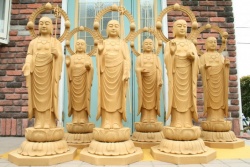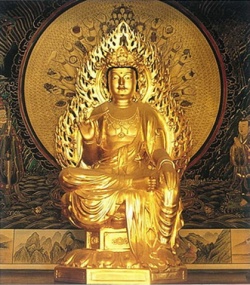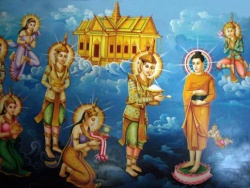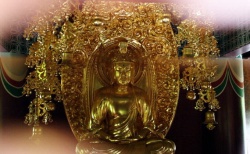The Buddhist Doctrine of Non-Self, and the Problem of the Over-Self
Y. Karunadasa, Middle Way (Volume 69:2 p. 107) August 1994
The early Buddhist doctrine of anatta has given rise to two main interpretations on the part of modern scholars. According to the mainstream view, anatta means the denial of a permanent self-entity, both at the microcosmic and the macrocosmic levels. However, scholars with a Vedantic orientation who tend to believe that early Buddhism is a systematic representation of the pre-Buddhist Upanisadic thought as well as those who believe in a perennial philosophy based on the transcendental unity of all religions, think otherwise. In their opinion, Buddhism believes in a Self (with 's' capitalized) which is not identical with any of the constituents (khandhas) of the empiric individuality taken severally or collectively, but which transcends them at both levels. This is what we have introduced in the title of this paper as the Overself. In this lecture we propose to discuss the early Buddhist doctrine of anatta or non-self and to examine, in the light of this discussion, whether the latter interpretation is tenable.
In our first lecture we observed that the Buddhist doctrine of anatta is the result of a critical response to the mutual opposition between ucchedavada and sassatavada which seek to explain the nature of the human personality on the basis of a physical and metaphysical self. Stated in negative terms, this means that Buddhism rejects the identification of a temporary (=ucchedavada) or an enduring (=sassatavada) self in the psychosomatic complex of the empiric individuality. What this means in more positive terms and on what grounds it is sought to be established are the two main problems which we propose to discuss in the first part of this lecture. For this purpose let us first consider in which sense the term atta or its negative form anatta is used in the Pali suttas. An inquiry into the various contexts should show that it is used at least in four interconnected senses.
One sense of the term anatta is that which has no independent existence and hence that which has no substantial nature of its own. This shows the close connection between anatta and the doctrine of dependent origination (paticcasamuppada). Since this latter doctrine maintains that nothing arises without depending on causes, it excludes the possibility of anything existing independently. Since the constituents that make up the human personality are described as dependently arisen (paticcasamuppanna pancakkhandha), it follows that within it there is no self-enduring substance or a self-entity existing by its own power.
The second sense of the term anatta comes into focus in the context of the Buddhist doctrine of impermanence. Thus in the Cha-chakka Sutta of the Majjhimanikaya we read:
"If anyone regards the eye (i.e. seeing) as the self, that does not hold, for the arising and passing away of the eye is (clear from experience). With regard to that which arises and passes away, if anyone were to think 'myself is arising and passing away', (such a thought) would be controverted by the person himself. Therefore it does not hold to regard the eye as the self. Thus the eye (or seeing) is (proved to be) non-self."
This same observation is made in respect of the other sense-organs, too. Let us take another example. Can feeling, for instance, be considered as the self? If it could be so considered, then, when a pleasant feeling gives place to an unpleasant feeling, one would have to admit that his self has changed, if it has not vanished completely.
A third sense in which the term atta appears to have been understood is in the sense of an agent, an actor distinct from action. This is clear from the oft-recurrent assertion that such statements as "through sense-impression is conditioned feeling", should not be understood to mean that distinct from feeling there is an agent who experiences it.
A fourth sense in which the term anatta is used could be detected from the Culasaccaka Sutta of the Majjhimanikaya, which records the well-known debate between the Buddha and Saccaka. The theme, of the debate was the Buddhist doctrine of anatta. Saccaka's argument is based on the premise that just as any kind of seed or vegetable grows and comes to maturity depending on the earth, even so whatever act a person commits, whether it is meritorious or demeritorious, depends entirely on the five aggregates (khandhas). Hence he concludes that the five aggregates constitute an individual's atta or self. In order to prepare the background for counterargument, the Buddha asks Saccaka whether the King of Kosala or Magadha has power or sovereignty over his subjects so that he could put to death one deserving to be put to death or to banish one deserving to be banished. When Saccaka admits that this is so, the Buddha puts this question to him: "When you assert that the five khandhas are yourself, have you power over them, have you control over them, so that you can say: 'Let my five khandhas be thus, let my five khandhas be not thus'?" Saccaka fails to give a satisfactory answer and admits that he was sadly mistaken in this matter.
What is most significant for our purpose here is the way the Buddha sought to refute Saccaka. It is based on the observation that if anything could be called atta or one's own self, one should have full control over it. The same idea is expressed in a number of other suttas in a slightly different form. We give below one relevant quotation:
"If, for instance, the physical body could be considered as the self, then this physical body would not be subject to affliction; one should be able to say (with practical results): 'Let my physical body be like this; let not my physical body be like that.' Because the physical body is not self, therefore it is subject to affliction."
This quotation also clearly shows that Buddhism understands atta as something over which one should have full control, so that it behaves in the way one wants it to behave. If something can be called my own, I should be able to exercise full sovereignty over it. This is the Buddhist definition of possession. What is hinted at is the idea that, since we do not have full control over our possessions, we are being possessed by our own possessions.
In fact, it is this same idea of atta that comes into focus in the logical sequence or interconnection between the three signs of existence (tilakkhana), namely impermanence (anicca), suffering (dukkha) and anatta. How the first two characteristics lead to the idea of anatta is shown as follows:
"Whatever is impermanent is suffering (yad aniccam tam dukkham); whatever is suffering is anatta (yam dukkham tad anatta)"
The question that arises here is why the idea of anatta is said to follow as a corollary from the fact of dukkha or suffering. This should become clear if we examine the three signs of existence in their reverse order. When examined in this context, the following facts become clear: I cannot consider anything as my own or as belonging to me (=atta), because whatever I consider so, is a source of suffering (dukkha). Why is it so? Because what I mistakenly consider as my own does not behave in the way I want it to behave. Why is it so? Because whatever I mistakenly consider to be my own is subject to constant change (anicca).
In point of fact it is this fourth meaning of anatta which, from the soteriological point of view, is the most important. However, it does not appear to have got due attention in the later schools of Buddhist thought as well as in modern writings on Buddhism. Perhaps this may indicate a shift of emphasis from Buddhism as a religion to Buddhism as a philosophy.
Now let us consider how the doctrine of anatta is explained in relation to the human personality. Buddhism seeks to analyse the empiric individuality in a number of ways, among which the most well known is the analysis into five aggregates (khandhas). They are: rupa (corporeality), vedana (feelings), sanna (perceptions), sankhara (mental formations) and vinnana (consciousness). According to Buddhism the whole world of experience is comprised within them and therefore the totality of our experience could be explained with reference to them. Hence it is the view maintained by Buddhism that if there were to be any kind of atmavada, it should originate only with reference to these five personality factors. They are the only ground for the origination of such an assumption. Let us take, for instance, the fifth aggregate, vinnana, or consciousness. if it is to be assumed as an atta such an assumption could manifest itself in four ways:
- (1) consciousness is the same as the self (vinnanam attato samanupassati), as in the case of a flame of a lamp which is identical with its visual appearance,
- (2) the self possesses consciousness, just as a tree has a shadow,
- (3) consciousness is within the self, just as the scent is in the flower, and
- (4) the self is in consciousness, just as a gem in a casket.
The other four aggregates (khandhas) could also be similarly considered. Thus there are in all twenty possible relations between the five aggregates and the hypothetical self. This is how Buddhism explains what is called sakkaya-ditthi-samudaya, the origin of the erroneous belief in a self-entity called atta.'
The Buddhist doctrine of anatta is intended as a remedy for the cessation of this erroneous belief (sakkaya-ditthi-nirodha)." This is sought to be achieved by the opposite process, i.e. by negating each aggregate as a self-entity, so as to eliminate all possibilities for the emergence of this notion. The final conclusion of this process of negation is that none of the five aggregates that make up the empiric individuality can be identified as one's own self.
The next question that arises here is that if each of the aggregates cannot be so identified, does their combination provide a basis for such an identification. In fact, a very strong argument for the possibility of such a conclusion was developed by a Buddhist monk called Khemaka as recorded in the Khemaka Sutta of the Samyuttanikaya." As recorded here, this monk developed a proper insight into the nature of the five aggregates, so that he did not discern either a self (atta) or anything pertaining to a self (attaniya) in any of the five aggregates. However, he had a lurking tendency to believe that there is some kind of self in the combination of the five aggregates. This belief was based on the conviction that what was lacking in each aggregate can be found in their combination. The combination is endowed with what each constituent is devoid of. When we speak of the scent of a blue or white lotus - so runs the argument - we do not say that the scent belongs either to its petals, or to its colour, or to its fibres. The right answer is that the scent belongs to the flower as a whole. In the same way, when we speak of the self, we do not say that it can be discovered in the constituents of the human personality when they are taken severally. The self which eludes us when we seek it in each aggregate could certainly be discovered in their combination. This argument seems to be based on the observation that the whole is not the mere collection of its parts, but that it is obtained when these self-same parts are organized in a particular order, so that there is a qualitative difference between the parts taken severally and their organized collection which is the whole.
However, this conclusion, on the part of Ven. Khemaka, though based on strong arguments, did not qualify him for final emancipation. This shows that, from the Buddhist point of view, his conclusion was wrong. Why is it so? In this connection we would like to make the following observations: it is, of course, true that Buddhism analyses the empiric individuality into five aggregates in order to show that none of them could be identified as a self-subsisting self-entity. However, it is not asserted that the individual is a mere collection of the five aggregates, just as much as a wall is not a mere collection of bricks. What is asserted is that the individual is the sum total of the five aggregates when they are organized together according to the principles of dependent origination (pancakkhandha paticcasamuppanna). What is denied in Buddhism is not the concept of person which is called puggala, but a self-subsisting entity within the puggala, which answers to the definition of atta. Therefore, Buddhism has no objection to the concept of puggala, if by puggala is understood, not an entity distinct from the sum total of the properly organized five aggregates, nor a substance enduring in time, nor an agent within the five aggregates. The puggala (person) is the sum total of the five aggregates combined according to the principles of dependent origination and which are constantly in a state of flux.
In which sense, then, can the combination of the five aggregates not be identified as one's own self? Of the four meanings of the term anatta which we discussed above, let us consider for our purpose here its meaning as that over which one does not have full control or power. Considered in the context of this meaning, it becomes clear that the five aggregates, whether they are taken severally or in combination, do not behave in the way one wants them to behave. For one does not have control or power over them. Therefore, the five aggregates, even when they are in combination cannot be identified as one's own self. This it appears to us, is the reason why Khemaka's conclusion was wrong - a conclusion which prevented him from attaining final emancipation. Up to now we have come to two major conclusions. One is that each of the five aggregates cannot be identified as a self-entity. The second is that the five aggregates in their combination, too, can not be identified as a self-entity. The next question that arises here is whether there is a self-entity over and above the five aggregates. This question is neither raised nor discussed in the early Buddhist discourses. Buddhism's silence on this question seems to be due to two reasons: one is that, according to Buddhism, the totality of empirical existence is comprised within the five aggregates (khandhas). The second is that Buddhism does not recognize a metaphysical reality, whether it is considered as transcendental or immanent which serves as a background to the world of sensory experience.
However, as we observed at the beginning of this lecture, this question is raised particularly by modern scholars with a Vedantic orientation and also by those who believe in a perennial philosophy based on the transcendental unity of all religions. The question is raised only to answer it in the affirmative. Hence it is that S. Radhakrishnan in his Indian Philosophy observes that the above question is related to two other questions, namely whether there is an absolute reality exempt from the changing world, and whether Nirvana is a positive being. Therefore he concludes that three questions are three different sides of one fundamental problem. He further observes that if the Buddhist answer to the first question is in the negative, then it inevitably follows that Nirvana is nothingness. That there is no logical sequence between these two propositions is a question that we propose to discuss in our lecture on Nibbana. Therefore we propose to confine ourselves to the first question: is there a permanent self over and above the changing aggregates?
Those who answer this question in the affirmative very often refer to the Sermon at Benares in support of their interpretation. The basic assumption behind this interpretation is that when the Buddha says that the five aggregates are not self (anatta), this does not amount to the denial of the Self. It only amounts to the fact that none of the five aggregates can be identified as our true Self, because they are subject to impermanence and also to what impermanence implies. The true Self is besides the five aggregates and could be discovered only by transcending them. For this purpose, the process of self-identification which manifests itself as: this is mine (etam mama), this I am (esoham asmi) and this is my self (eso me atta) should be replaced by the opposite process: this is not mine (netam mama), this I am not (nesoham asmi) and this is not my self (neso me atta). It is through this process of self-negation - so runs the argument - that one transcends the five aggregates and discovers his true Self. If the false self which is thus transcended, is subject to impermanence (anicca), suffering (dukkha) and characterised by non-substantiality (anatta), the true Self so discovered has the opposite three characteristics, namely, permanence (nicca), happiness (sukha) and the fact of being the true Self (atta). If man suffers it is because of his estrangement from his true Self. Therefore attainment of Nibbana means "a positive return of the self to itself".
If this interpretation is valid, it raises the very important question as to why the Buddha was silent on this matter. Why was the answer to it left to be implied or inferred? It also raises the equally important question why none, of the schools of Buddhist thought did not arrive at such a conclusion. Therefore it leads to the most improbable situation that they all misunderstood the original message of the Buddha. It is also worth mentioning here that among all the schools of Buddhist thought it was only the Vatisiputriyas, who believed in a puggala (person) which is supposed to be distinct from the sum total of the five aggregates. As claimed by the Vatisiputriyas, this did not amount to the belief in a soul as understood by many other Indian religions Yet for all, they came to be sarcastically referred to by other Buddhists as "heretics within our midst" (antascaratirthaka). Apart from these pieces of what may be called external evidence, there is internal evidence within the Pali texts which go against the theory of the Over-self.
In the Khemaka Sutta of the Samyuttanikaya," to which we referred above, it is recorded that a monk named Khemaka entertained the notion of "I am" (asmiti) in relation to the five aggregates. Then the other monks who were more knowledgeable put this question to him: "As to this notion of 'I am', friend Khemaka, of which you speak, what do you mean by this notion of 'I am'? Do you speak of 'I am' as body or as distinct from body, as feeling or as distinct from feeling, as perception or as distinct from perception, as mental formations or as distinct from mental formations, as consciousness or as distinct from consciousness?" From the context of the sutta, it is clear that these questions were put to Khemaka in order to show the correct view, namely that the notion of 'I am' cannot be applied either to the five aggregates or to 'something' distinct from them. This clearly establishes the fact that an independently existing self-entity cannot be discovered either within the five aggregates or besides them.
Another argument that has been adduced in support of the theory of the over-self is based on the Discourse on the Burden-bearer, which occurs in the Samyuttanikaya." It is interesting to note here that the discourse speaks of a burden (bhara), a bearer of the burden (bharahara), the lifting up of the burden (bharadana) and the laying down of the burden (bhara-nikkhepana). Here the burden means the five aggregates; the bearer of the burden is the person; its lifting up is craving and its laying down is Nibbana. Hence one who had attained Nibbana is called ohita-bhara, i.e. one who had laid down the burden. The fact that there is a reference here to a burden as well as to its bearer has given rise to the speculation that there is a person or a self-entity besides the five aggregates.
Yet another example that could be cited here in favour of such a conclusion is the Discourse on What is not Yours, which also occurs in the Samyuttanikaya. Here the Buddha advises the monks to put away what does not belong to them for the sake of their own profit and welfare. The reference is to the five aggregates (khandhas) because none of them could be identified either as a self (atta) or as something pertaining to a self (attaniya). This seems to imply that, although the five aggregates do not really belong to them, there is something besides, which really belongs to them, some kind of transcendental self which is not identifiable with any of the five aggregates.
Now the question that arises here is whether these two suttas, which we have referred to above, provide positive evidence for the theory of the Over-Self. Are we to base ourselves on two isolated statements as against the vast majority which provide positive evidence against such a theory. We believe that this kind of statement should be understood in the context of the Buddha's own advice as to how his discourses should be understood. We refer here to the distinction drawn between two kinds of discourse as nitattha and neyyattha The former refers to those statements which have their meaning "drawn out" (nita + attha), i.e. to be understood as explicit and definitive propositions. The latter refers to those statements whose meaning has to "be drawn out" (neyya + attha), i.e. to be interpreted in consonance with the fundamental teachings of Buddhism. As A. K. Warder observes, the distinction alluded to here may be interpreted in a broad way to mean the difference between the direct meaning and the suggestive or indirect meaning. This distinction is so important that to overlook it is to misinterpret the teachings of the Buddha. Hence it is emphatically stated: "Whoever declares a nitattha-discourse as a neyyattha-discourse and vice-versa - such a one makes a false statement with regard to the, Blessed One". It is in this context, we believe, that the two suttas, to which we referred above and others of a similar nature should be understood. They should be approached, not as direct and definitive statements (nitattha) but as statements which need to be interpreted (neyyattha) in the light of the fundamental doctrines of Buddhism.
Another sutta-passage which is often quoted by those who maintain the theory of the Over-Self is the one where a wandering ascetic called Vacchagotta asks the Buddha whether the atman exists or not. In each case the Buddha remained silent. This silence on the part of the Buddha, has been interpreted in two ways. According to Oldenberg it shows that the Buddha did not believe in any kind of ego (atman) and if he shirked the question raised by Vacchagotta it was in order not to shock a weak-minded hearer. On the other hand, Radhakrishnan says that he cannot agree with Oldenberg's view that the Buddha deliberately disguised the truth. He observes "that the logical conclusion from this would be that something is, though it is not the empirical self. We cannot agree with this interpretation because, as recorded in the self-same sutta the Buddha tells Ananda why he decided to remain silent when Vacchagotta asked whether there is a self or not. We would like to quote here the Buddha’s explanation as it clarifies the position we maintain, namely that there is no Over-Self besides the empirical self:
"If, Ananda, when Vacchagotta asked, 'is there an atman?' I had said, 'there is an atman, then I should have been one of those who hold the doctrine of eternalism (sassatavada). But if I had replied 'there is no atman', then I would have been one of those who hold the doctrine of annihilation (ucchedavada). And if, when Vacchagotta asked 'is there an atman' I had replied, 'there is an atman', would it have been in accordance with the knowledge that all things are without atman?' 'No, Lord,' if I had said, 'there is no atman, the bewildered Vacchagotta would have become still more bewildered, thinking, 'then did my atman exist before, and now it does not exist any more?""
Thus if any conclusion could be drawn from this answer, it is that Buddhism does not subscribe to the theory of the self as advocated both by sassatavada and ucchedavada.
Let us now consider the problem of the Over-Self in the light of the Buddhist observations pertaining to epistemology. In this connection it must be stated here that Buddhism recognizes not only different means of knowledge but also different levels of knowledge. Besides the ordinary sensory knowledge indicated by such cognitive terms as vinnana (bare awareness) and sanna (sensory perception), it speaks of a higher non-sensuous knowledge indicated by such cognitive terms as abhinna (higher knowledge), parinna (comprehensive knowledge), anna (gnosis), and panna (wisdom). If the first level of knowledge is circumscribed and influenced by our own subjective dispositions, the second level of knowledge is free from such limiting and conditioning factors. It is through this second kind of knowledge that one is said to be able to see things as they truly are (yathabhutam pajanati). As to means of knowledge, Buddhism recognizes not only sensory perception but also extra-sensory perception. This latter means of knowledge is said to enable one to cognize things which do not come within the ken or ordinary sensory knowledge. For our present purpose we need not go into their details. What matters here is the fact that, although Buddhism recognizes different means and levels of knowledge, it is never claimed that a permanent Over-self (the true self) transcending the empirical self (the false self) becomes an object of such knowledge. If anything becomes the object of higher knowledge, which provides a true vision and insight into the nature of reality (yathabhutananadassana), it is the five aggregates (the empiric individuality), and not an elusive Self which transcends them. In point of fact, one theme that runs throughout the Buddhist discourses is that it is the five aggregates that become an object of higher knowledge (Pancakkhandha abhinneyya parinneyya). Hence it is that to a question raised by the Buddha himself, namely: "What, monks, are the things that should be thoroughly comprehended through higher knowledge?" The Buddha himself provides the answer: "It is the five aggregates of grasping (= the empiric individuality) - so should it be answered". It is clear, therefore, that, according to Buddhism, the object of higher knowledge is not a higher reality, but the phenomenal world. This excludes the possibility of any metaphysical reality which serves as the ultimate ground of existence, no matter under what name it is introduced: the macrocosmic Soul, the First Cause, or the Transcendental Over-Self.
Another aspect that may be considered here is the experience gained through the higher stages of mind's concentration. We refer here to the Buddhist teaching on jhana, which recognizes eight (or nine) levels of mental concentration where each succeeding one represents a higher stage of the mind's unification. It is a process through which the differentiated mind gets gradually unified until it reaches a sublime level of mental refinement. The question that arises here is whether one who attains jhanic experience gets a glimpse of his true Self which was hidden to him during normal times. Can the jhanic experience be interpreted as communion of absorption with a metaphysical reality? In this connection we would like to quote here an observation made by the German Buddhist monk, Ven. Gnanaponika: "A fertile soil for the origin and persistence of beliefs and ideas about a self, soul, god or any other form of an absolute entity is misinterpreted meditative experience occurring in devotional rapture or mystical trance. Such experience is generally interpreted by the mystic or theologian as revelation of, or union with, a godhead; or it is taken for a manifestation of man's true and eternal Self."
That Buddhism does not interpret the content of jhanic experience in a mystic or metaphysical is clearly suggested by the Anupada Sutta in the Majjhimanikaya. Here we find an analysis, made by Sariputta, of the nature and content of the experience obtained through jhana, What is interesting to note here is the fact that the content of each jhana is fully itemized, without leaving any residue for any kind of mystic interpretation. Thus from the Buddhist point of view, it can be {{Wiki|psychologically]] analysed like any other mundane experience. What is more significant is the observation made that the mental constituents of each jhana are said to arise in full awareness of the meditator: "He is fully aware of their arising (vidita uppajjanti), their persistence (vidita upattanhanti) and their passing away (vidita abbhattham gacchanti). Then he comes to the conclusion that these mental factors, having not been, come to be (ahutva sambhonti), and, having been, they pass away (hutva pativenti). It is further observed that, since Sariputta fully comprehends the constituents of jhanic experience, he does not get attracted by them (anupaya) nor does he get repelled by them (anapaya), nor does he get attached to them (anissita) or infatuated by them (appatibaddha) Without getting overwhelmed by them he thus comes to the conclusion that there is an emancipation higher than that (atthi uttarim nissarananti pajanati).
Thus this account on the nature of jhanic experience establishes three facts: one is that its content could be fully analysed without leaving any residue. The second is that its constituents arise and vanish in full knowledge of the meditator. The third is the fact that it does not in itself constitute final emancipation. For, according to Buddhism, the jhanic experience, too, is impermanent (anicca), unsatisfactory (dukkha), and devoid of a self (anatta), conditioned (sankhata) and is of dependent origination (paticcasamuppanna). These observations on the nature and content of jhanic experience clearly show that it cannot be interpreted in terms of mysticism or metaphysics, i.e., as providing proof for the existence of the Over-Self. In point of fact, Buddhism seems to be fully aware of the possibility of misinterpreting it on the basis of theological or metaphysical theories. This seems to explain why the meditator is advised to review the content of jhanic experience in the light of the three marks of phenomenal existence (tilakkhana), i.e., as impermanent (anicca), unsatisfactory (dukkha) and as devoid of a self-subsisting entity (anatta).
The next aspect that must be taken into consideration for a final solution to the problem of the Over-Self is the Nibbanic experience. This is an aspect which we propose to take up in our lecture on Nibbana. However, for our present purpose, it is necessary to refer here to one important aspect of the Nibbanic experience. This refers to the position of the Tathagata, i.e. one who has attained Nibbana, in relation to the five aggregates (khandhas). In the Buddhist texts, it is claimed that the Tathagata cannot be comprehended either with reference to the five aggregates or without reference to them. The first suggests that the Tathagata does not identify himself with any of the aggregates or the personality-factors. The second suggests that he does not identify himself with anything outside the aggregates, i.e., something than transcends them, as for example the Over-Self. Both means that the Tathagata is free from all forms of self identification. From this it must not be concluded that one who has attained Nibbana identifies himself with Nibbana, as is clearly shown in the first sutta of the Majjhimanikaya. Such an identification according to Buddhism amounts to a serious form of spiritual bondage. In the context of the Buddhist teaching on anatta, the Upanisadic statement, namely "I am Brahman" or "Thou art That" is a form of asmimana, self-identification. According to the Buddhist view of emancipation, there is no emancipation as long as asimana persists. This is clear from the story of the Buddhist monk called Khemaka to which we referred in the course of this lecture.
From what we have observed so far it should become clear that the Nibbanic experience, too, does not provide evidence for the theory of the Over-Self, a self that transcends the empirical self. That the ideal of emancipation as conceived by early Buddhism has no parallel to that of the Upanishads is a subject that has been studied by a number of modem scholars. In the context of these studies, Radhakrishnan's conclusion that early Buddhism is only a restatement of the thought of the Upanishads from a new standpoint needs revision. As Helmuth Von Glasenapp observes it is of course true that early Buddhism and the Upanishads share many doctrines in common, such as Karma, rebirth and deliverance through insight. However, as he further observes, since these ideas were commonly held by a number of contemporary religions, such as Jainism, it is not possible to determine which influenced Buddhism. The fact that the Upanishads preceded early Buddhism does not necessarily mean that the latter was a linear development of the former. For it is a well-known fact that in the history of thought new ideas could emerge not only as a further refinement of earlier ideas but also as a reaction against them, i.e. in dialectical opposition to them. In both cases the influence of what precedes for the emergence of what succeeds is undeniable. However, the difference in the two kinds of influence is also unmistakable. As we observed in our first lecture, Buddhism emerged, not as a linear development of either sassatavada or ucchedavada, but as a critical response to their mutual opposition.
This brings us to an end of our inquiry into the Buddhist doctrine of anatta. What is radical about this doctrine is that it provided a new dimension to the concept of the human personality and laid the foundation for a psychology without the psyche - if by psyche is understood a self-subsisting entity within the recesses of our mind. As Edward Conze observes, the specific contribution of Buddhism to religious thought lies in its insistence on the doctrine of 'not-self’. In point of fact, Buddhism's other contributions to philosophy, psychology and ethics have all flowed from it. For if Buddhist philosophy seeks to show why the idea of a self-entity is a wrong assumption, its psychology shows how it comes to be, its ethics shows how it can be overcome and its final goal which is Nibbana shows the final state where it is completely eliminated. This is not to suggest that the Buddhist doctrine of anatta makes Buddhism either superior or inferior to other world-views. Ours is only an academic exercise, and the main thrust of our argument is to show where Buddhism differs.













